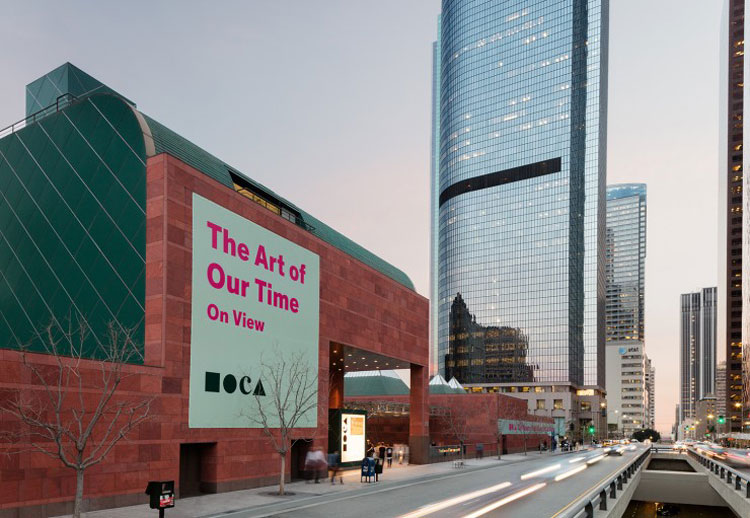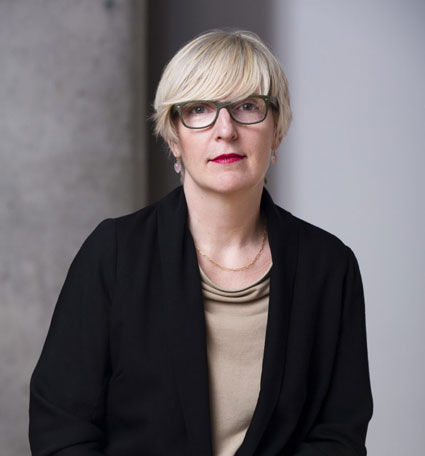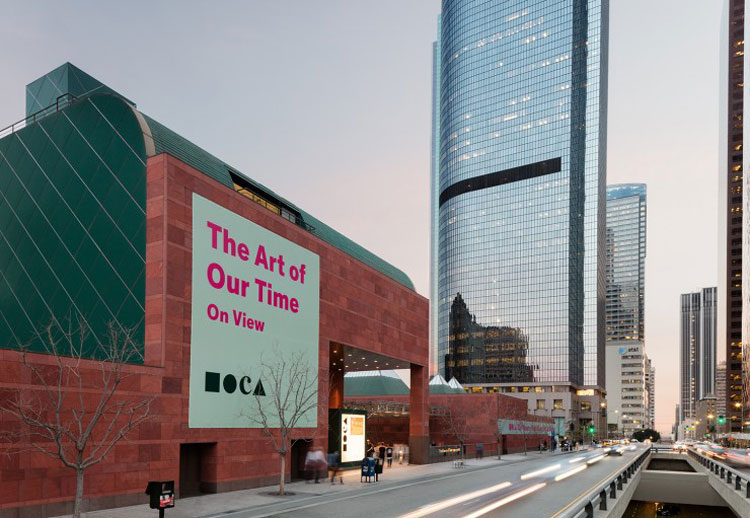[ad_1]

Exterior of the Grand Avenue branch of the Museum of Contemporary Art in Los Angeles.
ELON SCHOENHOLZ/COURTESY THE MUSEUM OF CONTEMPORARY ART, LOS ANGELES
As questions swirled last week around the dismissal of Helen Molesworth as chief curator at the Museum of Contemporary Art in Los Angeles, reactions were swift and sweeping, with some holding up the imbroglio as an example of a respected female museum professional unfairly maligned and others insistent that there is more to the story. On Friday, Julia Halperin of Artnet News published a report detailing ways in which both could be true.
In a chronicle that suggests changing mores among museum directors and curators in relation to artists and, more pointedly, donor-class collectors and members of museums’ boards, Halperin reported clashes between Molesworth and others in that latter camp that might have figured into her firing. In one, the curator reportedly snubbed the artist Mark Grotjahn—the subject of previous controversy at MOCA involving his selection and ultimate rejection of an honor to be bestowed by the museum at a since-cancelled fundraising gala that was scheduled for this spring—by sending a junior curator in her place to a meeting about a proposed retrospective.
The Grotjahn meeting wasn’t the only occasion in which Molesworth was allegedly a no-show. Speaking to ARTnews, one philanthropist, collector, and donor to MOCA described an event at the donor’s home that had been set up after Molesworth requested a tour of the donor’s collection. “Philippe asked if he could bring Helen and the staff and a group of important international collectors,” the donor, who spoke on the condition of anonymity, said. A date was arranged, and food was procured for a cast assembled for the gathering. But then “everyone showed up except for Helen,” the donor said. “I saw Philippe on the phone frantically trying to get in touch with her. No one from the museum nor I had heard word that she wasn’t coming. I was sure she had an emergency.”
After no acknowledgment for several months, the donor wrote to Molesworth, who responded, without apology, that she couldn’t attend because she had gone on a studio visit instead, the donor said. “I thought it showed not just disrespect for me but incredible disrespect for Philippe, in front of his staff and these major collectors. Helen has undermined and eroded the reputation of the museum.”

Helen Molesworth.
COURTESY MOCA
In her Artnet News report, Halperin quoted a different unnamed collector who spoke of a collection visit in which Molesworth showed up but paid what he regarded as insufficient interest in his collection. That collector said, “It made me feel naked—it made me feel uncomfortable because she came to see my collection and made me feel like she really didn’t like it. She didn’t even pretend to like it.”
The news of such interactions has brought about much discussion over curators having to kowtow to wealthy collectors. But, the MOCA donor reached by ARTnews said, “the idea that donors or patrons to museums are just there to have people genuflect to them, that’s absolutely not true. I want to be left alone. I don’t show my collection to many people—it’s in my home. But Helen begged me twice to see the collection and then when I set it up, she no-showed me—and then never contacted me again. Are you just supposed to put up with this sort of thing over and over again?”
Management style has also emerged as a potential problem and possible cause in Molesworth’s dismissal, with Hyperallergic reporting a number of cases in which the chief curator was thought to be severe in her handling of staff. David Bradshaw, a former technical manager for exhibitions at MOCA who was fired by Molesworth, told Hyperallergic that Molesworth “latched on” to a group of employees and “assaulted them psychologically and emotionally until they either quit or were beaten down with lists of fabricated missteps to justify their labelling as inept and fired.”
ARTnews spoke with several more former employees who described similar scenarios.
Gladys-Katherina Hernando, a former curatorial assistant at the museum and a cofounder of the Los Angeles alternative space JOAN, told ARTnews that “there was a sense of intimidation happening on the floor, in the hallways. She became very aggressive with some people who had been there for a long time, people with seniority.”
Speaking to her own experience with Molesworth, Hernando added, “Even if I did everything correct, I felt I was set up for failure. I knew that I couldn’t win. For some reason, she targeted me and went after me. She was a bully.”
Hernando added that “[Helen] and Philippe were very close”—and that the director gave her a lot of freedom. “He was always very supportive [of her],” Hernando said. “I don’t think the question is about conflicting ideologies or contradictory agendas. I think the issue is about her character as a person and a boss.”
Another former MOCA employee, who spoke on the condition of anonymity, described the workplace environment that Molesworth created as “demoralizing,” with treatment including demotions and screaming at people in front of colleagues. “It’s a serious issue when you destroy people psychologically and morally,” the ex-employee said, calling Molesworth’s behavior a “well-known secret” among staff and former colleagues. “I don’t think her departure is at all what had been portrayed at the beginning: an issue of disparate curatorial values or gender discrimination.”
A third former MOCA employee, who also spoke on the condition of anonymity, said, “Molesworth’s behavior in a position of power needs to be more fully addressed.” This former employee added, “I understand that new chief curators often hire and fire staff to build their ideal team. Unfortunately, however, when she came on, she completely disregarded much of the hard work and dedication that many people on the staff, such as David Bradshaw, gave to the institution. Helen proceeded to fire, demote, and shift people’s positions around within the institution, while giving no attention to the impactful work that they had done in their previous roles.”
Another subject of controversy in the wake of Molesworth’s firing has been what some, especially in the immediate aftermath of the news last Tuesday, have characterized as a clash of comportments in regard to interests in cultural and curatorial diversity. But one L.A.-based curator, speaking anonymously, counseled against reading the split between the two as caused by differences of the kind. The curator noted that the Guatemalan-born curator Alma Ruiz, who was long one of the few people of color in a curatorial department at a major museum in L.A., left MOCA after working with both Vergne and Molesworth. “More than everything,” this person said, “it is striking how badly this reflects on the institution. At this point, it seems that MOCA is out of touch with the broader conversations of inclusivity.”
When Ruiz left the museum in 2015 after 31 years, in a move that was characterized as a retirement but has since been described as a forced exit by multiple sources and in some reports, she described a museum that had been in disarray for some time. “Nowadays exhibitions are easily cancelled,” she told a local television station in 2016. “Contracts are rescinded. Staff is fired overnight . . . This behavior is very damaging to the institution and to the trust that supporters put in the institution.”
Many who have come out in support of Molesworth have emphasized her approach to diversity and inclusion. Simone Leigh, an artist whose work Helen Molesworth wrote about in the latest issue of Artforum, said that Molesworth “has altered the way we think about the canon by putting a spotlight on holes in our thinking about art history.”
“She has backed up her radical theory with the formal rigor required to get everyone’s attention,” Leigh said. “Her enthusiasm has extended to support institutions like the Underground Museum, which, with its partnership with MOCA, has become one of the most important museums in the country. I could go on and on. It’s impossible not to see the connections between this spectacle, Laura Raicovich’s similar conundrum in New York, and the outsized criticism of Nancy Spector’s offer to Trump. These curators are reflecting the work of artists who are engaged with institutional critique and dismantling white supremacy. We’re not going back.”
But the patron and MOCA donor who was allegedly “no-showed” by Molesworth cautioned against a stark view of Vergne as otherwise inclined. “Anyone who yells ‘inclusivity’ or ‘diversity’ and that Philippe is not supportive of that is absolutely, blatantly wrong.” Among the evidence cited were shows and close associations over the course of Vergne’s career with artists including Kara Walker, Nari Ward, Huang Yong Ping, David Hammons, Mark Bradford, and Song Dong, among many others. The donor said of Vergne and Molesworth, “He hired her. He had been protecting and troubleshooting for Helen for far longer than he should have, and he did it until he could no longer justify it because it was eroding the reputation of the museum.”
Joel Wachs, currently president of the Andy Warhol Foundation for the Visual Arts and a former longtime MOCA board member who was on the search committee that recruited Vergne, said, “There’s a very wrong impression that somehow or another Philippe doesn’t stand for diversity. He’s all about that—he brought her in for that reason. A great contemporary museum needs a balanced program, and I think he has very much provided that.”
Nari Ward, an artist who has worked with Vergne in the past and is currently consulting with him on a prospective MOCA acquisition of one of his works, said, “Early on, when Philippe was talking about this acquisition, he would mention Helen. He was very proud that he hired her. He hired her particularly because she was bringing an aspect he wanted to the conversation, so to separate them now is strange.”
“It’s too easy to demonize one or the other,” Ward added.
While expressing support for Vergne, Ward said the director “needs to check himself—and maybe all museum directors need to think about this—against the role of collectors in programming. We’re going through an era where collectors are more dominant than ever before, and most of them are not morally held accountable. It’s a warning to every museum director.”
Many museum professionals who know both Molesworth and Vergne look on with a mix of vexation and disappointment.
For some, like Kathy Halbreich, the news brought up tensions that can arise between the different dictates of curatorial and directorial roles. Before moving into her more recent roles as associate director and curator at MoMA and the recently appointed director of the Robert Rauschenberg Foundation in New York, Halbreich worked with Vergne—she as director and he as chief curator—at the Walker Art Center in Minneapolis. Of the challenges and opportunities particular to both roles, she told ARTnews, “I know from years of managerial experience that it is very possible to be a great curator and a less good leader; those skills are just not synonymous.”
Halbreich acknowledged the human element on either side. “Just as I believe the best directors care profoundly about the creative life of artists and never lose their feel for the pleasures and challenges of the studio, a great chief curator cares for and is a guardian of people as well as objects. Nothing made me happier than to see the people who worked with and for me prosper both at the Walker and beyond. That’s essential to who Philippe is, too.”
“This all makes me sad,” Halbreich said. “The lives of two very smart people are being toyed with in ways that just seem cheap to me. Neither deserves this public vilification—and neither does MOCA.”
What will happen with MOCA in the coming days and weeks will be closely watched. “I wish them well, although it will be very, very difficult for them to recover from this,” Lari Pittman, an artist who left MOCA’s board in January over the governance and management of the museum, said. “I can’t imagine anyone wanting to apply for the new chief curator position. I can’t imagine anybody wanting in the future wanting to apply as director. It’s going to be a slow recovery, and they must do penance.”
Update, 3/20/18, 10:00 a.m.: The context of Kathy Halbreich’s comments has been edited to clarify that she was speaking generally about differences between directorial and curatorial roles.
Alex Greenberger and Andrew Russeth contributed to this report.
[ad_2]
Source link

